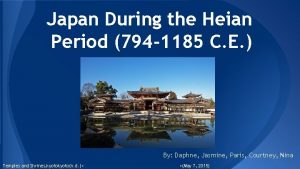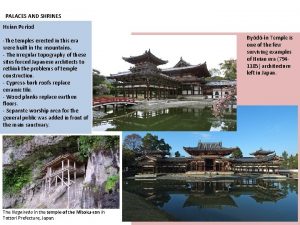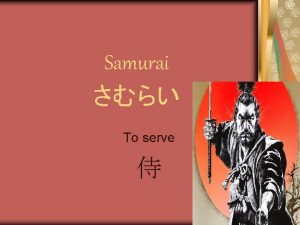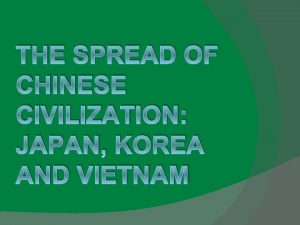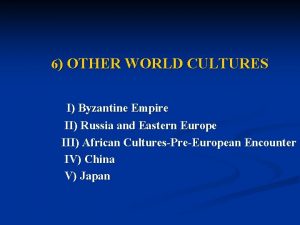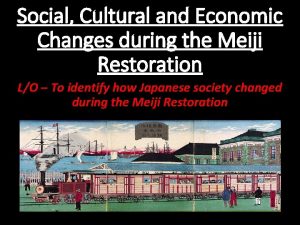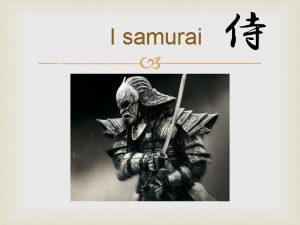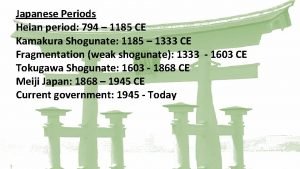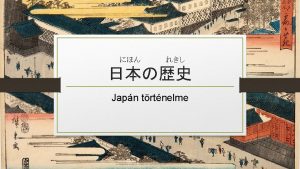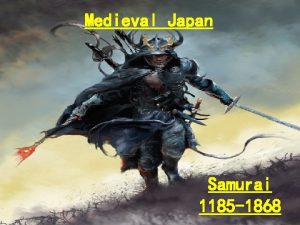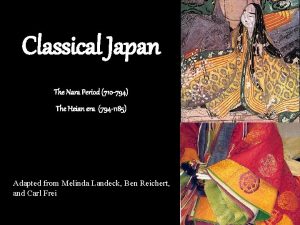Samurai To serve Heian Period 794 1185 The
















- Slides: 16

Samurai さむらい To serve 侍

Heian Period (794 -1185) The samurai's importance and influence grew during the Heian Period, when powerful landowners hired private warriors for the protection of their properties.

Towards the end of the Heian Period, two military clans, the Minamoto and Taira, had grown so powerful that they seized control over the country and fought wars for supremacy against each other.

Kamakura Period (1192 -1333) In 1185, the Minamoto defeated the Taira, and Minamoto Yoritomo established a new military government in Kamakura in 1192. As shogun, the highest military officer, he became the ruler of Japan.

Muromachi Period (1333 - 1573) During the chaotic Era of Warring States (sengoku jidai, 14671573), Japan consisted of dozens of independent states which were constantly fighting each other. Consequently, the demand for samurai was very high. Between the wars, many samurai were working on farms.

Many of the famous samurai movies by Kurosawa take place during this era.

Azuchi-Momoyama Period (1573 1603) When Toyotomi Hideyoshi reunited Japan, he started to introduce a rigid social caste system which was later completed by Tokugawa Ieyasu and his successors. Hideyoshi forced all samurai to decide between a life on the farm and a warrior life in castle towns. Furthermore, he forbade anyone but the samurai to arm themselves with a sword.

Edo Period (1603 - 1868) According to the Edo Period's official hierarchy of social castes, the samurai stood at the top, followed by the farmers, artisans and merchants. Furthermore, there were hierarchies within each caste. All samurai were forced to live in castle towns and received income from their lords in form of rice. Masterless samurai were called ronin and caused minor troubles during the early Edo Period.

With the fall of Osaka Castle in 1615, the Tokugawa's last potential rival was eliminated, and relative peace prevailed in Japan for about 250 years. As a result, the importance of martial skills declined, and most samurai became bureaucrats, teachers or artists. In 1868, Japan's feudal era came to an end, and the samurai class was abolished.


Who were the Samurai? The Japanese feudal military aristocracy. A professional warrior belonging to this class.




The battle of Sekigahara

Samurai kimono
 Heian period social classes
Heian period social classes Kalio jododas
Kalio jododas Samurai to serve
Samurai to serve Samurai to serve
Samurai to serve Samurai to serve
Samurai to serve Worx landroid front wheel replacement
Worx landroid front wheel replacement Heian court hierarchy
Heian court hierarchy Heian-kyo the heart of japan's golden age
Heian-kyo the heart of japan's golden age Fujiwara clan today
Fujiwara clan today Shikabu
Shikabu Spread of china's literature to heian japan and korea
Spread of china's literature to heian japan and korea Kanshibun
Kanshibun Moraleja del samurai
Moraleja del samurai Seven samurai of systems engineering
Seven samurai of systems engineering Byzantine definition
Byzantine definition Feudal japan hierarchy
Feudal japan hierarchy Meiji restoration samurai
Meiji restoration samurai
